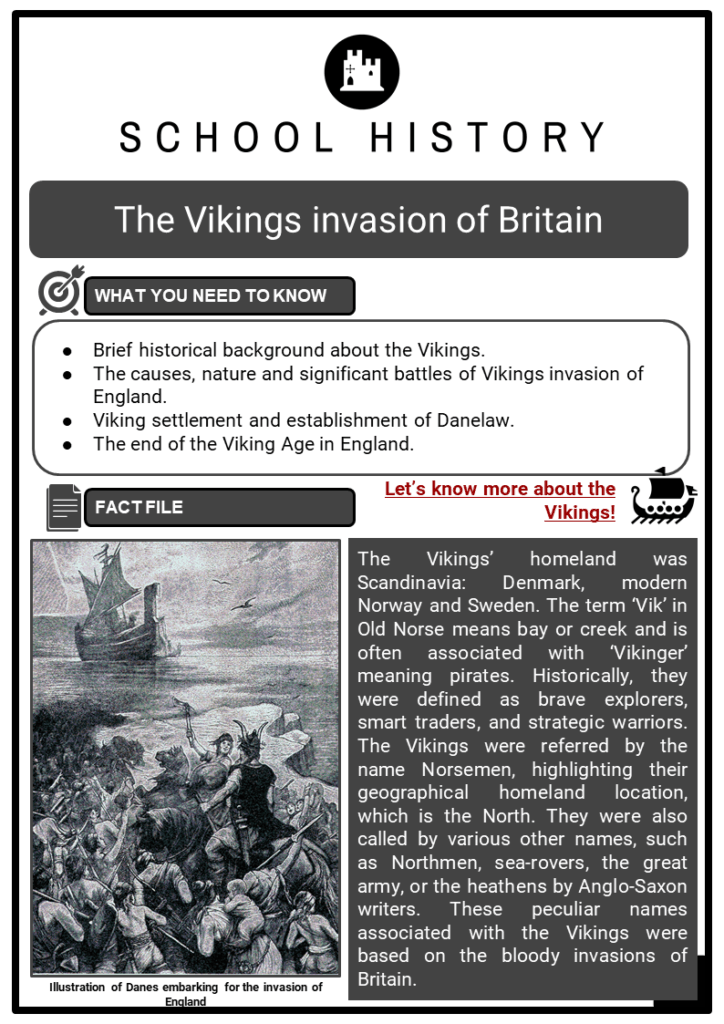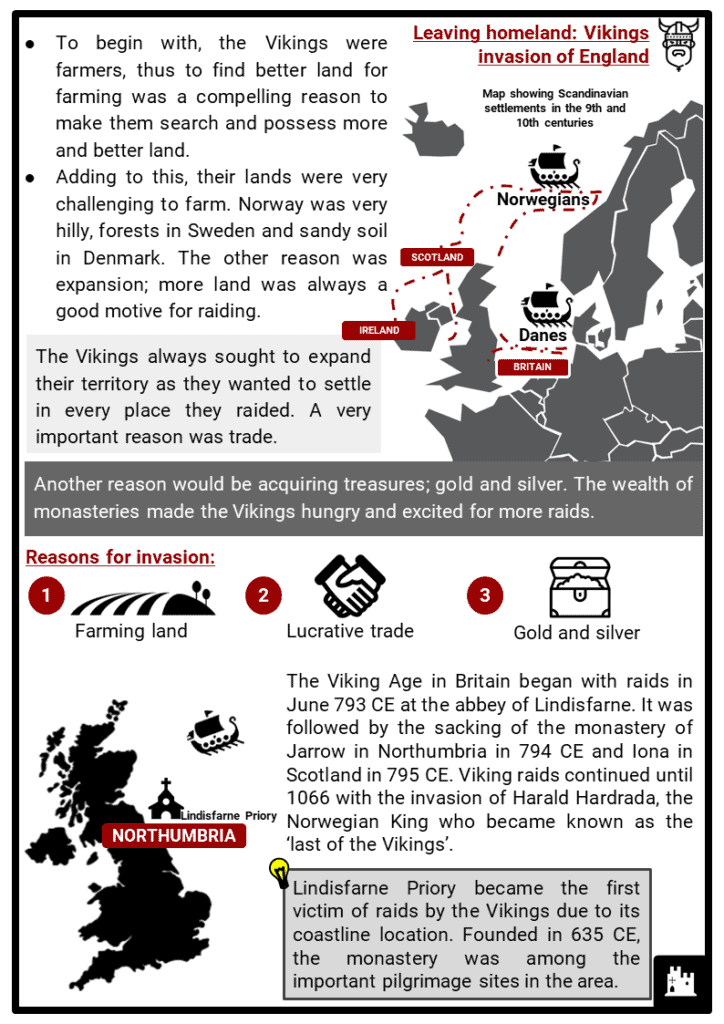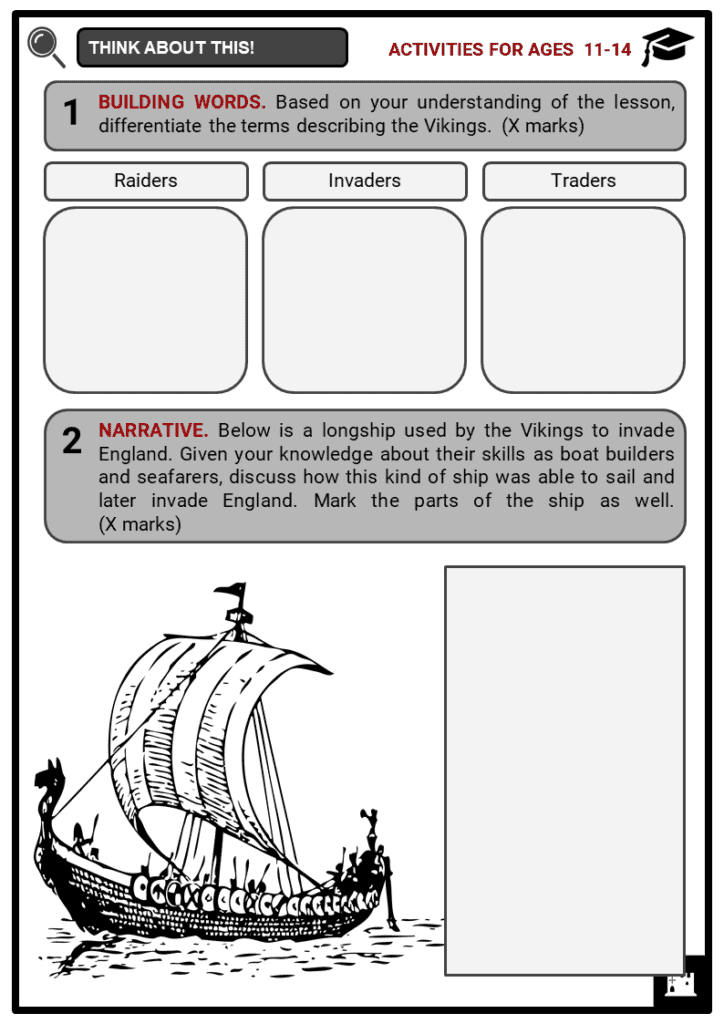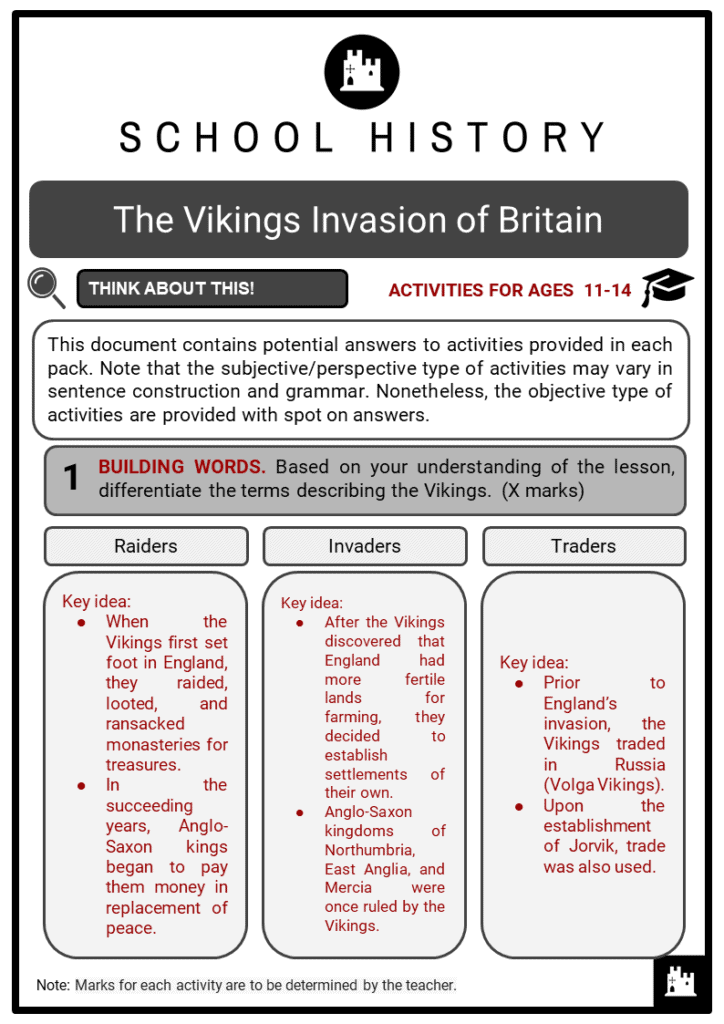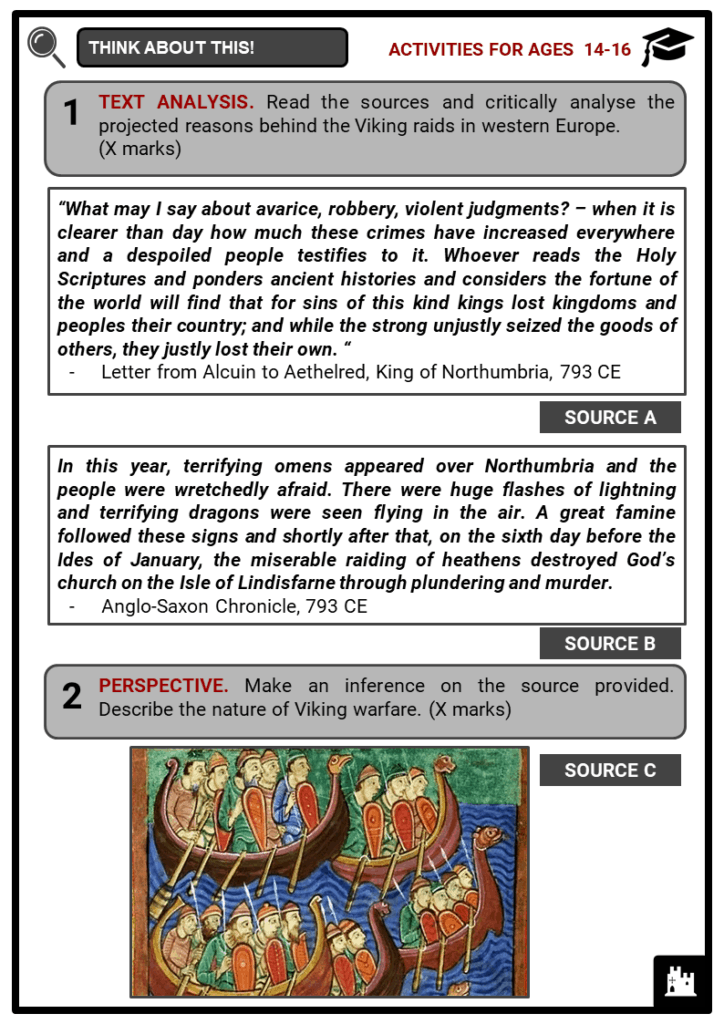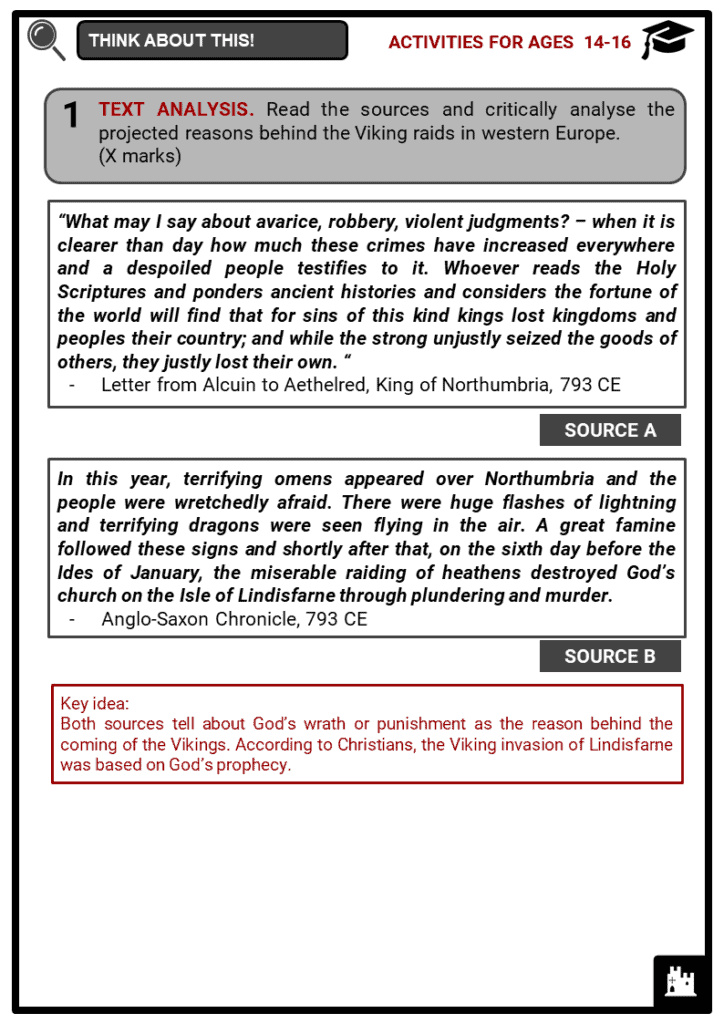Download The Vikings Invasion of Britain Worksheets
Do you want to save dozens of hours in time? Get your evenings and weekends back? Be able to teach The Vikings Invasion of Britain to your students?
Our worksheet bundle includes a fact file and printable worksheets and student activities. Perfect for both the classroom and homeschooling!
Table of Contents
Add a header to begin generating the table of contents
Summary
- Brief historical background about the Vikings.
- The causes, nature and significant battles of Vikings invasion of England.
- Viking settlement and establishment of Danelaw.
- The end of the Viking Age in England.
Key Facts And Information
Let’s know more about the Vikings
- The Vikings’ homeland was Scandinavia: Denmark, modern Norway and Sweden. The term ‘Vik’ in Old Norse means bay or creek and is often associated with ‘Vikinger’ meaning pirates. Historically, they were defined as brave explorers, smart traders, and strategic warriors. The Vikings were referred by the name Norsemen, highlighting their geographical homeland location, which is the North. They were also called by various other names, such as Northmen, sea-rovers, the great army, or the heathens by Anglo-Saxon writers.
- These peculiar names associated with the Vikings were based on the bloody invasions of Britain.
Leaving homeland: Vikings invasion of England
- To begin with, the Vikings were farmers, thus to find better land for farming was a compelling reason to make them search and possess more and better land.
- Adding to this, their lands were very challenging to farm. Norway was very hilly, forests in Sweden and sandy soil in Denmark. The other reason was expansion; more land was always a good motive for raiding.
- The Vikings always sought to expand their territory as they wanted to settle in every place they raided. A very important reason was trade.
- Another reason would be acquiring treasures; gold and silver. The wealth of monasteries made the Vikings hungry and excited for more raids.
Reasons for invasion:
- Farming land
- Lucrative trade
- Gold and silver
- The Viking Age in Britain began with raids in June 793 CE at the abbey of Lindisfarne. It was followed by the sacking of the monastery of Jarrow in Northumbria in 794 CE and Iona in Scotland in 795 CE. Viking raids continued until 1066 with the invasion of Harald Hardrada, the Norwegian King who became known as the ‘last of the Vikings’.
- Lindisfarne Priory became the first victim of raids by the Vikings due to its coastline location. Founded in 635 CE, the monastery was among the important pilgrimage sites in the area.
- The Holy Island of Lindisfarne was the first target of the Viking invaders. The Norsemen landed on the island, stole treasures, destroyed religious relics, killed monks, and they left the monastery bloody, sinking in its own ruins. The attack on Lindisfarne left the people of Britain in shock and fear.
- Snatching the gold and silver from the pious place, made the Norsemen more eager to organize more raids. The British religious isles could not stand as a resisting power to the Vikings’ raiding force, that fact favoured the Norsemen, and encouraged them to further attack Britain.
- In the following years, the Norsemen kept going on raiding missions accompanied with small raiding parties. Their motive was to plunder the land’s riches.
- However, those small raiding parties ceased plundering the riches of the coastal villages when three Viking leaders came to unify the armies of the north. The three Viking leaders sought more than riches, they sought land. Thus, Britain was more threatened with what was referred to as the great heathen army.
- The second big raid took place in AD. 865. The great heathen army had other motives than to snatch the gold and silver of the monasteries. This army was an organized invasion force, consisting of warriors from both Denmark and Norway.
- According to some historians, the fleets of the Norsemen came under the leadership of the famous warlord Ragnar Lodbrok’s sons, Ubba, Ivar The Boneless, and Halfdan Ragnarsson. They landed with the invasion force on the coast of East Anglia.
- They settled for a while before capturing Northumbria and York. Followed by a series of attacks, Wessex was the only Anglo-Saxon kingdom that wasn’t under the Vikings control.
- At saint’s day, York was attacked by forces led by Ivar the Boneless, and Halfdan in AD. 866.
- The town of York was exposed to the great heathen army raid; all the leaders were in the Cathedral which made them vulnerable and unready for battle. York was renamed “Jorvik” after being conquered, and it was made the capital of the Vikings settlements in Britain.
- By AD.886, the Vikings forces failed to conquer Wessex in the first two attacks. At that time Wessex was under the rule of Alfred the Great.
- The Norsemen produced textile, forged weapons, made glass and jewels in York. This capital proved to be a great economical trade centre. Jorvik’s last ruler, Eric Bloodaxe, also known as “the bloody tyrant”, was thrown out of York in AD. 954. After the town was reclaimed under the Anglo-Saxon rule.
- The third attack on Wessex was followed by a meeting between Guthrum, the leader of the Viking invaders, and Alfred the King of Wessex to negotiate terms of a peace treaty. Guthrum was baptised and given the name “Athelstan” when the peace treaty was established. In return, he was formally recognized as the King of East Anglia by King Alfred the Great. The first article of the treaty draws the boundaries of the Vikings settlement in East Anglia.
- Viking army under Halfdan Ragnarsson
- By 873, the kingdom of Mercia completely fell to the Vikings. After eight years of raiding England, the Heathen army split in half. Halfdan Ragnarsson conquered the north, while the other half moved south.
- Viking army led by Guthrum
- As Halfdan conquered the north, his army began to plough the land and established farms. In the south, his brother Guthrum faced a series of battles against King Alfred.
- At the Battle of Edington, the Anglo-Saxons were victorious against the Vikings. As a result, Wessex became the only kingdom free from the Vikings.
- In the mid 10th century, the second Vikings age rose from Denmark’s emerging power. The Vikings started striking the British Isles again. The Anglo-Saxon army met bitter defeat against the enormous Danish force at the battle of Maldon.
- Raids kept taking place to ravage the major towns in England. Taxes of silver and gold were imposed on the Anglo-Saxons’ towns and leaders. It crippled the process of raising a force in order to resist the Vikings’ control.
Establishment of the Danelaw
- Given the success of the Viking expansion in the 9th century, Danelaw, which refers to the lands to the north and east of England, were conquered by the invaders.
- Under the Danelaw, five fortified towns, which became known as the Five Boroughs, were established. Leicester, Nottingham, Derby, Stamford, and Lincoln. These five towns under the control of the Vikings followed Danish law and customs.
- A total of fifteen shires were included in the Danelaw. Leicester, Nottingham, Derby, Lincoln, York, Essex, Cambridge, Suffolk, Northampton, Norfolk, Huntington, Bedford, Middlesex, Hertford and Buckinghamshire.
- A Danish Jarldom ruled each borough controlling the lands and answered to a Jorvik or overlord in the Viking Kingdom of York.
- By 942, King Edmund recovered the Five Boroughs from the Vikings.
- For some time, the Danelaw established civilian peace between the neighbouring Anglo-Saxon and Viking communities.
- As a result of this co-existence, many Norse words were mixed into the the English language.
- In order to eliminate challenges to the throne, especially from the Wessex dynasty, Cnut executed a number of noblemen. Etheling, son of Ethelred, fled from England but was later killed, while his half-brother to Emma of Normandy, Edward, was sent into exile.
- In July 1017, he married Emma, widow of Ethelred and daughter of Richard I of Normandy. Their son, Harthacnut was later named as his heir.
- Upon collecting enormous Danegeld, Cnut paid off his army and sent the majority home. In addition, heregeld, an annual tax to pay the army, was also collected.
- The Danelaw constitution was reinstated. Moreover, he strengthened the system of coinage.
By 1033, Wessex came under the control of Godwin, an influential Anglo-Saxon family from Sussex. Later on, Cnut allowed Anglo-Saxon nobility whom he trusted to dominate the lands.
The end of the Viking age in 1066 was due to a conflict over the throne. After marking the death of Anglo-Saxon King Edward the confessor. Harald, a Viking ruler, claimed his rightful place to the throne of England, regarding an agreement between him and the successor of Cnut’s son. - Harald sailed to England with 300 ships filled with 11 000 warriors. He planned to seize the throne from Harold Godwinson. The Norsemen King Harald invaded York for a first stop.
- However, that did not last long, because the King of England was already expecting a Norsemen invasion from the south. Thus he acted upon his expectations and moved his troops fast. With possessing the element of surprise, he crushed the Norman army.
- According to historians, only 24 ships out of 300 returned to their homeland. Harold Godwinson’s army was weakened despite his success over the Norman invaders. Then three weeks later, he was attacked and defeated by William Normandy. But the end of the Vikings age was marked with the death of King Harald and the crushing of his force.
Significant battles between the Vikings and Anglo-Saxons
- The Battle of York
- The Norsemen army, lead by the three sons of Ragnar Lodbrok; Ivar, Ubba and Halfdan set foot in East Anglia in 865 AD. The Scandinavian forces were given treasures, horses, and food from the local East Anglicans who sought peace. This suited the Vikings army as they longed for reinforcement. Then they marched north.
- As was mentioned before, the Vikings forces waited for saint’s day to attack York. The Vikings are usually characterised as fierce warriors and rarely tactile. However, this invasion proved the opposite.
- The Invasion of Wessex
- The great heathen army captured East Anglia and York. Then Ivar the Boneless decided to take half of the forces to Ireland while Halfdan remained with a respectable amount of soldiers in England.
- Soon, Ivar began to raid and plunder the wealth of the countryside of Wessex. However, when Halfdan was raiding along the banks of the River Kennet, a portion of Wessex army led by Ealdorman Athelwulf took them by surprise and that was a great loss for the Vikings. In this battle, the Normans made a tactical mistake which is separating their forces.
- The Anglo-Saxon army killed Halfdan and crushed his army, only a few men were left alive to tell the story of the first Anglo-Saxon victory over the Vikings.
- The Battle of Edington
- The epic battle upon the hills of the city Edington was planned by Gathrum. He placed his army above the hills forcing a battle to his favour.
- Although Guthrum was well planned, and his defensive tactics were great, the Anglo-Saxon army was able to wipe the Vikings defences after a very lengthy battle. That resulted in many deaths of both forces. The Vikings power gradually decreased and finally, Guthrum fled with a small portion of his army.

